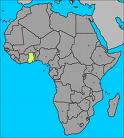Yesterday was my lucky day. I had been waiting impatiently to witness births here at the hospital, but had yet to really have a chance beyond glimpses from afar when the woman gave birth on the floor, or peeking into the labor ward when trying to get ahold of the elusive delivery book. But yesterday, the nurse-midwife in charge had me copy the data from the book at the nurse's desk right in front of the two birthing tables (usually they give me the books and I take them to the waiting room where the women in first stage labor are waiting to reach second stage- this is where the "floor births" take place).
As it was Monday, we were having to collect data on every delivery from Friday, Saturday and Sunday, which ended up amounting to 117. Needless to say, I spent a good 3+ hours in that delivery room copying the delivery information onto my data sheet (which is then taken back to our work room where we upload it into our computer databases).
And during this time, I witnessed 8 births. Births in the labor ward - I can assure you - are nothing like ones back home (although truthfully I've never witnessed one in the States). Besides the occasional "floor deliveries" in the first stage labor waiting room, the labor ward boasts of 8 beds with mostly naked women in various stages of 2nd stage labor, some naked, others half clothed. Some screaming, some moaning, and some snapping their fingers (a sign of pain). Meanwhile, doctors, nurses, med students, and occasional research teams such as mine are wandering through. Although there are curtains hanging from the ceiling in front of each bed, they have remained tied up. When a woman must relieve herself, she does so in her "hot bucket", a small plastic pail with lid that the women must provide themselves to urinate and defecate in. They simply get off the bed and squat over the pail between the beds.
In the adjoining room is the delivery room with its two labor tables and newborn assessment area in the corner. Across from these is the nurse desk where they write down the delivery information in the patient files and record them in the delivery book. It is also the resting place for the nurse-assistants, nurse-midwives, and any other helpers or researchers such as myself - all approximately 3 feet from the table where the laboring woman is lying with her legs spread.
The deliveries were fascinating: the women are not given any drugs - no epidurals or easy ways out like we have - and yet most women remain incredibly in control, although there is of course a number of women who make plenty of noise. Part of the reason they are often so quiet is that it is a Ghanaian belief that a woman should be quiet during birth to prove her maternal strength. And part of it is that the nurses often yell and sometimes even hit women who choose to scream or cry out.
From my sitting point three feet from expanding vaginas I was able to watch (amid writing names, dates, times) the nurse-midwife as she aided the baby's head to first emerge, then checked with her finger to make sure the cord was not wrapped around the baby's neck, then watch carefully for the shoulders to rotate before pushing the head down and freeing the shoulder as the rest of the grey body quickly followed.
Birth number four was interesting from the beginning. The young woman was put in the stirrups, and after abour 5 minutes her contraction slowed, and then seemed to cease altogether. Now normally, the woman is in and out of the stirrups in 10 minutes by the time they get her in there (because there are only two delivery tables they can't afford to put women in them until they are literally delivering, because there are so many more waiting). But this young woman (about my age) had been on the table for about ten minutes making no sounds. I was hardly surprised, therefore, when the nurses gave her an IV drip with oxytocin, which is a drug used to induce uterine contractions to progress the labor development.
The nurses, nurse assistants, nursing students, janitors, and myself were all looking on intrigued, asking about the treatment and how long it would take to kick in etc. Within two minutes, the woman began groaning and fidgeting, and I suddenly saw her stomach contract down as if the baby was about to burst out....when suddenly her waters broke, shooting a HUGE projectile stream three feet out, and directly onto three of the nursing students's laps. I was mostly spared - it only got on my shoes. We were all pretty shocked, as none of us had realized her waters hadn't yet broken.
But this was only the beginning. As the time between contractions became closer, it was apparent that the baby's head was not going to fit through the small vaginal opening. The nurse-midwife made the decision for an episiotomy, and using a small razor blade, told the woman to push and cut the perineum little by little with each push so that the woman would not feel the cuts through the other pain.
The baby's head soon followed, and was delivered shortly after. It didn't take long for the placenta to follow. The nurse took the pail where the blood had dripped into and poured it into a large measuring cup - 800 ml of blood, she nnounced. This is quite a lot, given that most women we record average 150-250 ml of blood loss. Anything over 600 ml is a potential case for a blood transfusion.
I then watched a different nurse suture her episiotomy closed, and as aweful as a comparison it was, I could only think about how similar the technique seemed to the stitches I received from my skiing accident a few years back...
I thought I might have had to interview this woman today if she ended up indeed having a blood transfusion, but luckily she never showed up today on our list of complications. I was greatful for the opportunity to see how hard the nurse-midwives work to safely deliver babies as easily as possible for the laboring mothers. I was in total awe of this young woman's strength and courage - of every woman's - to sacrifice her body in order to bring a new being into this world. And I was relieved for having a lap free of her labor waters.
Subscribe to:
Post Comments (Atom)












No comments:
Post a Comment